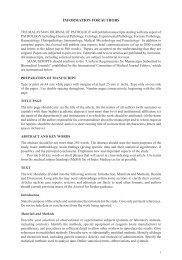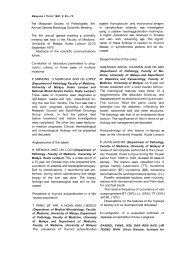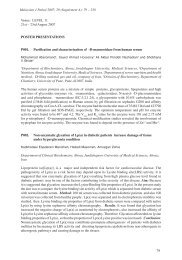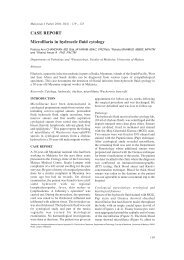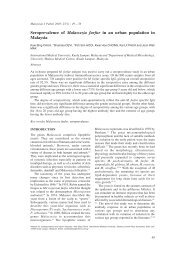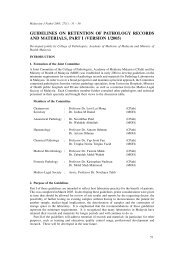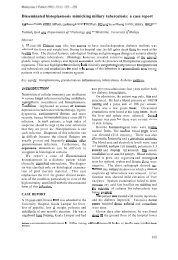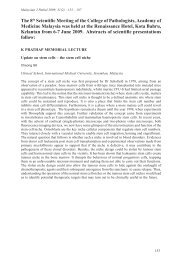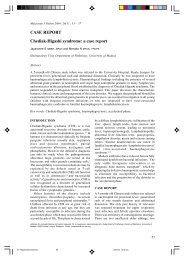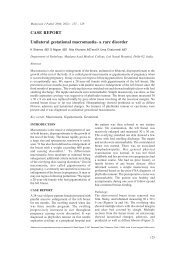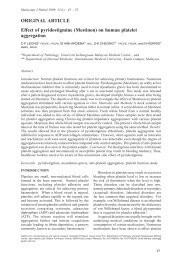CASE REPORT Haemoglobin Lepore in a Malay family: a ... - MJPath
CASE REPORT Haemoglobin Lepore in a Malay family: a ... - MJPath
CASE REPORT Haemoglobin Lepore in a Malay family: a ... - MJPath
You also want an ePaper? Increase the reach of your titles
YUMPU automatically turns print PDFs into web optimized ePapers that Google loves.
<strong>Malay</strong>sian J Pathol June 2005A diagnosis of heterozygous haemoglob<strong>in</strong><strong>Lepore</strong> was made for both parents. The parentsare first degree relatives. The patient’s andparents’ samples were sent for DNA sequenc<strong>in</strong>gwhich confirmed this unknown haemoglob<strong>in</strong> tobe Hb <strong>Lepore</strong> Wash<strong>in</strong>gton Boston. The patientis on regular follow-up and has received 3 bloodtransfusions at 4 -5 monthly <strong>in</strong>tervals s<strong>in</strong>ce thetime of diagnosis.DISCUSSIONHb <strong>Lepore</strong> is a common abnormal haemoglob<strong>in</strong>seen <strong>in</strong> the Mediterranean region. It is the mostcommon abnormal haemoglob<strong>in</strong> <strong>in</strong> Caucasians<strong>in</strong> Central Portugal and <strong>in</strong> the Spanish AltaExtremadura. 1 It is a variant form of humanhaemoglob<strong>in</strong> that conta<strong>in</strong>s delta beta hybridcha<strong>in</strong>s or a fused glob<strong>in</strong> cha<strong>in</strong>, from the productof a hybrid gene: the unequal cross<strong>in</strong>g overbetween the delta and beta glob<strong>in</strong> genes result<strong>in</strong>g<strong>in</strong> a deletion of 7.4kb <strong>in</strong> the beta glob<strong>in</strong> genecluster. 1,2Three different types of Hb <strong>Lepore</strong> have beendescribed so far, each with a different crossoverbreakpo<strong>in</strong>t: Hb <strong>Lepore</strong> Wash<strong>in</strong>gton Boston, Hb<strong>Lepore</strong> Baltimore and Hb Hollandia. 1,2,4 Thebasic defect <strong>in</strong> all the Hb <strong>Lepore</strong> disorders is the<strong>in</strong>efficient synthesis of the delta beta fusioncha<strong>in</strong>s of Hb <strong>Lepore</strong>, which leads to a variabledegree of glob<strong>in</strong> imbalance, excess alpha cha<strong>in</strong>production and the cl<strong>in</strong>ical phenotype of betathalassaemia. The <strong>in</strong>effective erythropoiesis andthe shortened red cell survival results from thedeleterious effects of excess alpha cha<strong>in</strong>s. Theselection of cells which are synthesiz<strong>in</strong>grelatively more gamma cha<strong>in</strong>s follow the samemechanism as occurs <strong>in</strong> beta thalassemia. 5 It hasbeen postulated that the deletion which resulted<strong>in</strong> the delta beta fusion is somehow responsiblefor <strong>in</strong>creas<strong>in</strong>g the absolute output of gammacha<strong>in</strong>s. 6 This is compatible with the observationthat Hb <strong>Lepore</strong> heterozygotes producesignificantly more Hb F than beta thalassaemiaheterozygotes.The Hb <strong>Lepore</strong> heterozygotes are usuallyasymptomatic. In a large Italian series noabnormal physical signs were reported, but afew of the Greek and Yugoslavian heterozygoteshad mild splenomegaly. 7,8 Heterozyogotes aretherefore healthy <strong>in</strong>dividuals with only a slightdecrease <strong>in</strong> haemoglob<strong>in</strong> levels, but with adist<strong>in</strong>ct microcytosis and hypochromia of theirred blood cells. The mean cell haemoglob<strong>in</strong>(MCH) is thought to be the most reliableparameter that is altered <strong>in</strong> the Hb <strong>Lepore</strong>heterozygotes (range 20-25 pg). 9 In this series,the red cell <strong>in</strong>dicies and morphologicalappearances of the blood film of betathalassaemic carriers were compared with thatof heterozygous Hb <strong>Lepore</strong>. It was found to besimilar <strong>in</strong> both conditions. Studies suggest thatthere are no major differences <strong>in</strong> thehaematological f<strong>in</strong>d<strong>in</strong>gs between carriers of thedifferent molecular varieties of Hb <strong>Lepore</strong>. 1 Redcell survival and ferrok<strong>in</strong>etic data available revealred cell survival is slightly shortened and Fe 59utilization is <strong>in</strong>creased. 10The Hb <strong>Lepore</strong> homozygotes vary <strong>in</strong> theseverity of their cl<strong>in</strong>ical manifestations. 6,7,8 Atone end of the spectrum are patients who presentwith<strong>in</strong> the first 5 years of life with severe anaemiawith haemoglob<strong>in</strong> values rang<strong>in</strong>g from 4 to 7 g/dl. Significant splenomegaly, hepatomegaly, andskeletal abnormalities <strong>in</strong>dist<strong>in</strong>guishable fromthose of homozygous beta thalassaemia are seen.These patients require regular blood transfusionand exhibit shortened life span. At the other endof the spectrum are patients who have a milderdisorder <strong>in</strong>dist<strong>in</strong>guishable from beta thalassemia<strong>in</strong>termedia, who are anaemic throughoutchildhood and require only occasional bloodtransfusions. The homozygous state for Hb<strong>Lepore</strong> therefore varies from a transfusiondependent disease like beta thalassaemia majorthrough the milder spectrum of thalasaemia<strong>in</strong>termedia that appears to be compatible withlongevity of life. 5 The haematological f<strong>in</strong>d<strong>in</strong>gs<strong>in</strong> these patients are peripheral blood film features<strong>in</strong>dist<strong>in</strong>guishable from the severe forms of betathalassaemia. Bone marrow smears show markederythroid hyperplasia due to high level oferythropoiet<strong>in</strong> production <strong>in</strong> response to theanaemia. 6The multifaceted approach for thepresumptive identification of haemoglob<strong>in</strong>variants <strong>in</strong>cludes a scrut<strong>in</strong>y of blood counts/redcell <strong>in</strong>dices and haemoglob<strong>in</strong> analysis. Thisapproach easily identifies Hb <strong>Lepore</strong>. Oncellulose acetate electrophoresis at alkal<strong>in</strong>e pH,Hb <strong>Lepore</strong> shows electrophoretic mobilitysimilar to Hb S. 5 The other haemoglob<strong>in</strong>s thatrun <strong>in</strong> this position are Hb D and Hb G, whichare differentiated from Hb S by sickle solubilitytest and electrophoresis at acid pH. Hb <strong>Lepore</strong>has a similar retention time (RT) value as Hb A2on high performance liquid chromatography(HPLC) analysis with the Bio-Rad Variant<strong>Haemoglob<strong>in</strong></strong> test<strong>in</strong>g system. 2 Values greaterthan 10% suggest the presence of variant36




